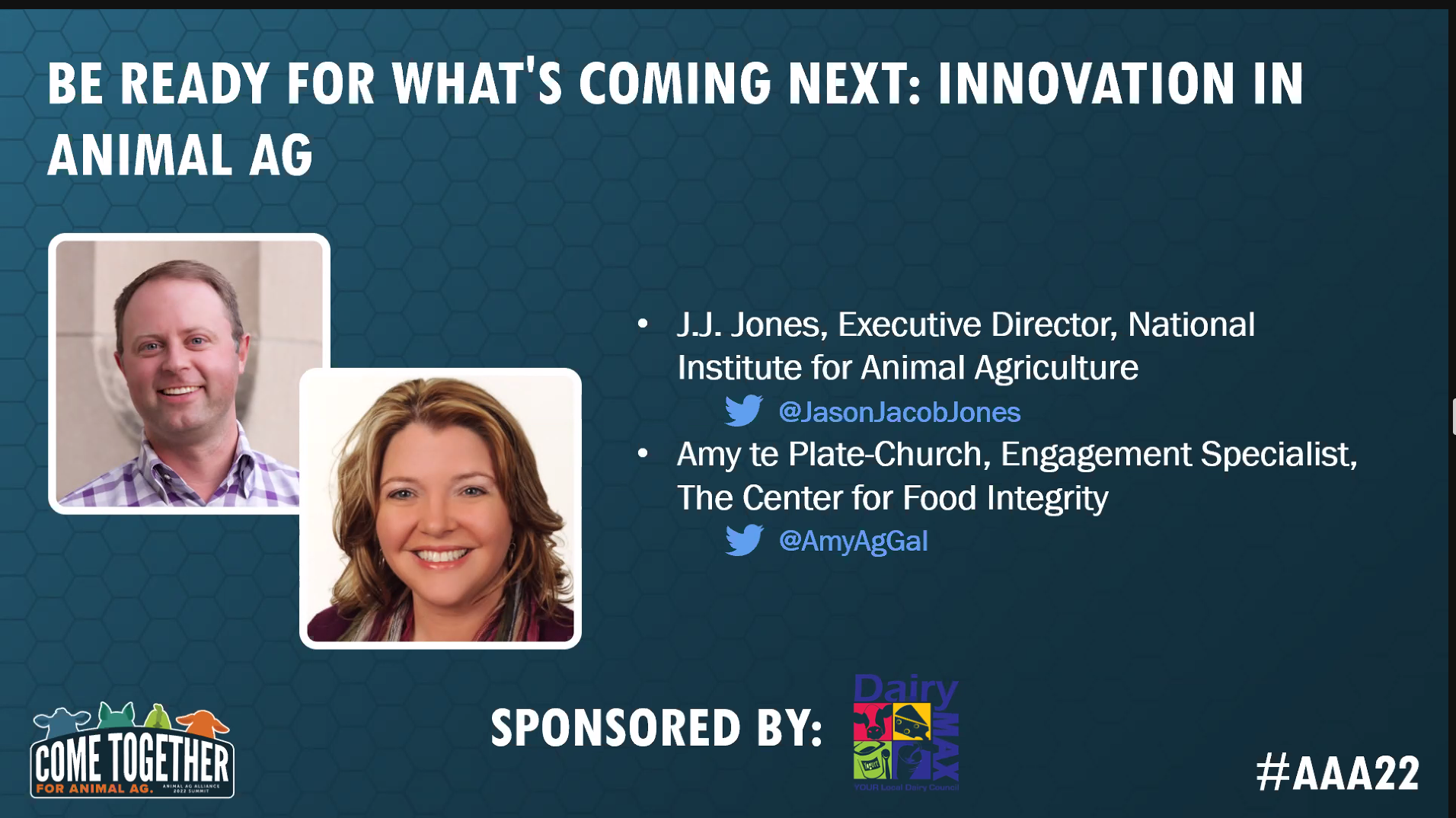It’s not always as simple as growing a crop or raising a steer to feed people.
Agriculture in the United States is constantly being analyzed and under the microscope as farmers and ranchers try to meet sustainability and environmental, social, and governance goals.
According to the Animal Agriculture Alliance, tech and innovation will be critical for animal ag to rise to the challenge. Of the nearly $20 billion in venture capital that was invested in Agri-Food Tech startups in 2019, only part of went to animal ag. AAA hosted a webinar recently discussing what’s coming next for the livestock sector.
During the webinar, experts JJ Jones and Amy te Plate-Church explained some possible solutions to these challenges, as well as how they can be funded and accepted by consumers. Jones is the executive director of the National Institute for Animal Agriculture, and te Plate-Church is an engagement specialist at The Center for Food Integrity.
By 2019 many in livestock and food circles started seeing the significant advancement in the investment in the food and ag tech segments—$19.8 billion went into the value chain. Those dollars, however, were only those publicly discussed.
“So there may have been private investments that that happened that were not issued in a press release or did not flow through a channel where we could find that information,” Jones said. “But that’s a fairly large and significant investment that’s taking place.”
Jones feels animal ag and the food system goals are being set by various organizations and groups when it comes to various aspects of the food system.
He has looked at topics like greater productivity and how to ensure protein supplies are available to friends, family, and neighbors across the country and around the globe.
“We’ve looked at goals around preserving lifestyles, how do we ensure that the next generation of family members or business owners can take over our sector of animal agriculture and really then in terms of certain proteins, species specific for example, our goal has been how do we compete with other species protein,” Jones said.
When it comes to the venture capital numbers, in 2019 there was a significant increase in investment by venture capitalists in food and agritech areas. Jones said when those groups are looking where to invest, there’s six primary factors they look for. Those factors include: character, capacity, creativity, community, sustainability, and financial outlook.
“I think that’s also important for us and food and agriculture, no matter where we are at in supply chain or the value chain, to think about how do we help entrepreneurs and innovators identify where we need creative solutions,” he said. “So is this innovation or technology good for the community?”
Investors are looking for sustainable or long-term plays. It can’t just be a flash in the pan type activity or innovation, Jones said, it has to be one that has long-term viability.
“So that they can find their return on investment because obviously, that’s what venture capital is going for,” he said. “And then in the same terms, what is the financial outlook is the growth rate there for this innovation or this technology.”
Jones said the numbers he shared demonstrate that venture capitalists and others in the tech and innovation space are very interested in food and ag tech. Looking deeper at the $19.8 billion investment across the supply chain in 2019, Jones began to dissect how much was going into technologies at the farm and ranch level on through the consumer products. He also wanted to dissect the $7.6 billion and how much was going towards crop versus animal agriculture.
“According to the USDA Economic Research Service, animal agriculture and crop agriculture in the United States are equal in terms of gross receipts,” he said. “If we’re comparing dollars to dollars, it would be reasonable to say that of that $7.6 billion 50% should go towards crops and 50% should go towards animal agriculture, because again, in terms of gross receipts, they’re equal economies.”
“I would say our strengths were a highly desired food physically and mentally,” he said. “There’s a reason alternative protein companies want to call their product, meat or dairy or eggs or poultry or fish. People not only physically, but mentally desire our products.”
Animal protein is a complete protein, with many beneficial nutrients, vitamins and minerals. It also has a rich global history and it’s cultural—a lifestyle and utilitarian need around the globe. When it comes to weaknesses though, Jones said animal ag can be a late adopting industry and is highly segmented and fragmented. It is also slow to engage in emotional conversations.
Jones believes those in animal agriculture need to continue to make sure they’re giving consumers permission to enjoy animal derived proteins.
Sign up for HPJ Insights
Our weekly newsletter delivers the latest news straight to your inbox including breaking news, our exclusive columns and much more.
“We know they want them. They’re having ethical concerns about animal welfare, environmental stewardship, and other factors that we have to give them permission to overcome,” he said. “We have to have greater collaboration especially on pre competitive areas, whether that’s around food safety, animal welfare, antimicrobial resistance, environmental stewardship, and more.”
Jones said there are threats that all those in agriculture need to be watching for—things like social license and freedom to operate. Be aware of issues like climate change, global warming and cooling as they are affecting not only animal agriculture, but all parts of society.
“We have a role to play in climate change. So we need to be ready to adapt and engage there,” he said.
The final issue to be aware of is zoonotic diseases, as it’s estimated each year animal agriculture is affected by disease to the tune of over $220 billion.
“So this not only is a significant economic loss, but it’s an animal welfare issue,” Jones said. “It’s a food security, a food safety issue in some cases, that we need to make sure we’re watching and staying on top of.”
Center for Food Integrity
There have been a lot of consistent findings when talking about public acceptance around animal proteins and the role tech plays in our sustainable future, te Plate-Church said.
“Innovation and proven technologies that are close to production agriculture, we know that those technologies are essential to creating enough safe, healthy and affordable food while achieving those environmental and sustainability goals,” she said.
The question that has to be answered is how acceptance is earned for tech in agriculture.
“And that was exactly the question that we at CFI sought out to answer about a year ago,” she said. “Specifically, what are the drivers of acceptance and rejection of the technology that’s being used in food and agriculture when we know that there’s such broad adoption of technology in other areas.”
The goal of CFI and United Soybean Board in this research was to develop a model that classifies existing and future technologies, along with key factors that are known to be associated with consumer acceptance. They identified four different factors that are believed to be significant drivers of acceptance or rejection of tech in food. Those include: voluntary exposure, perceived naturalist, perceived dread and technology perceived control. When it comes to consumer characteristics they found four key drivers—disgust sensitivity, general attitudes towards new technologies, cultural values and personal identification.
“Heuristics are those mental shortcuts in decision making, and they stand in for the detailed technical knowledge when making a decision,” she said. “So if I don’t completely understand the science or the technology, these are shortcuts I take to form a conclusion.”
The heuristics that drive acceptance include those images that are positive or negative that are associated with the tech, a belief around natural is better or the previous or current offerings are better than the technology being proposed.
“But most importantly, and really the foundation of this driver is the trust heuristic,” she said. “And that includes trusted people in organizations, as well as trust in the technology itself. So to open the door with consumers about technology, they must believe that the technology comes from trustworthy organizations who are acting responsibly, and they have credible people that are championing and developing the technology.”
The public must see the benefits of the technology are aligned with societal values, and those benefits justify trusting the technology, outweighing any perceived risks.
“The perceived risks can definitely negatively impact especially if they’re around food safety, or personal health, the environment and animals,” she said. “Those areas really can carry more weight. Ultimately, for acceptance, the perceived benefits must outweigh or at least be equal to those perceived risks.”
In their results they found millenials have the most positive impression of technology used to grow food. Gen Z was a very close second. Early adopters significantly showed the most positive impression of technology used to grow food in the U.S.
“So the top tier driver, the number one thing was eating food containing gene edited plants is safe for consumers,” she said. “That’s followed by a couple of second tier drivers. Gene editing of plants promotes greater sustainability of food production through higher crop yields. I think it’s pretty fascinating.”
The second tier driver was confidence in the techniques because they’re used in human medicine. Then a set of what te Plate-Church called third tier drivers.
“They’re also influential, not as quite as much as the others I described, but technology to edit the genes of plants is available to all farmers and growers,” she said. “There’s an equity and fairness of use.”
CFI research confirmed what te Plate-Church as seen across food and agriculture.
“This is the foundation for acceptance—readily access to information and positive attributes promotion of the benefits,” she said. “We really need to emphasize that that end product is based on nature, when that’s true and safe for consumers to ingest.”
In the absence of a specific understanding and knowledge around the technical details, buyers often take shortcuts in decision making.
“That’s really what’s key to public trust when we’re making those mental shortcuts is trusting the organizations that develop technologies and those organizations that approve and monitor the impact of technologies,” she said.
The benefits must outweigh the perceived risks of ingesting food that’s been derived through technology, and those perceived benefits must resonate with the public and outweigh potential risks.
“Those of us in production agriculture, we certainly know that farmers, industry researchers, scientists are continually finding new ways to use innovation and produce crops and animal proteins that are increasingly sustainable,” te Plate-Church said. “And there’s a great story to tell around that.”
Based on what is known and what CFI continues to learn about consumer motivations, she believes when societal benefits, food safety, responsible use is presented transparently, consumers appreciate the value and potential agriculture brings to achieve sustainability and food security goals.
For more information about the survey visit www.foodintegrity.org.
Kylene Scott can be reached at 620-227-1804 or [email protected].



